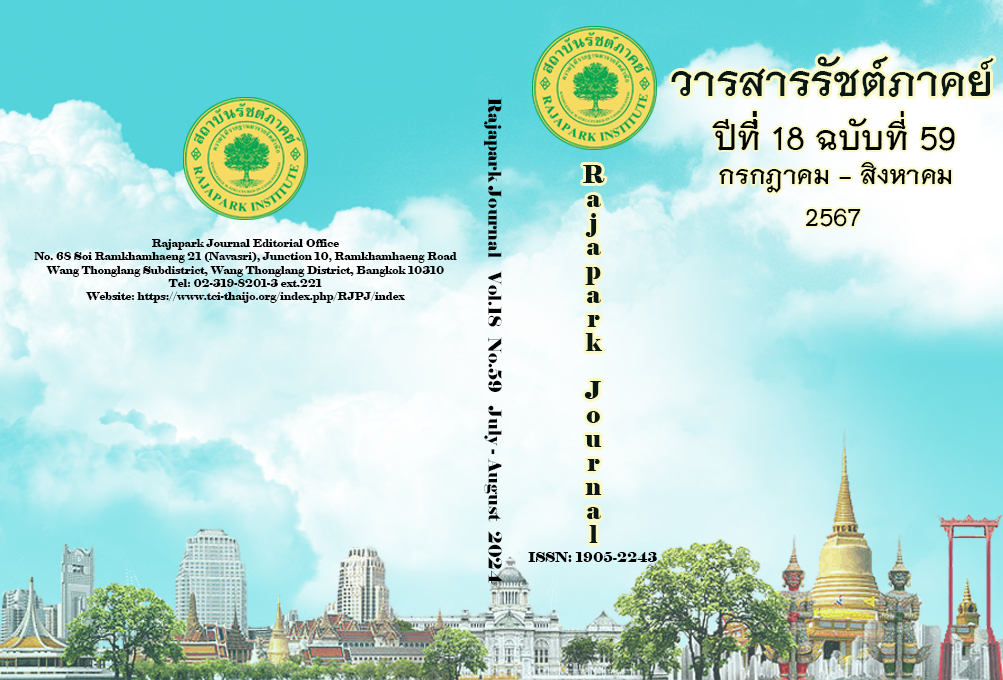A Model of Administration for Innovative Organizations for Opportunity Extension Schools under the Office of Basic Education Commission
Main Article Content
Abstract
This research aims to develop a model of administration for innovative organizations in Opportunity Extension Schools. The research methodology consists of three steps, as follows: 1) Studying the components and guidelines of administration for innovative organizations 1.1) Studying the components of administration for innovative organizations, the process involved surveying 340 administrators of Opportunity Extension Schools using a 5-point Likert scale questionnaire and confirmatory factor analysis.1.2) Studying the guidelines of administration for innovative organizations: A Semi-Structured Interview Study with 7 Qualified Individuals. Data analysis utilized the Content Analysis Method. 2) Developing administration for innovative organizations, performing model analysis, and evaluating the suitability of the model. The tools used to gather data include 15 expert model assessments. 3) Evaluate a model of administration for innovative organizations with a sample group of 254 administrators who were leading innovation in the Education sandbox. The tools used to gather data include an evaluation of the possibilities and benefits of the model. The results indicated that the model created by the administration for innovative organizations consisted of three parts: principles and objectives, process, and success conditions. And the created model was highly suitable, according to expert opinions. Moreover, the assessment results of the model of administration for innovative organizations show a high level of possibilities, with the highest level of benefits.
Article Details

This work is licensed under a Creative Commons Attribution-NonCommercial-NoDerivatives 4.0 International License.
Views and opinions appearing in the Journal it is the responsibility of the author of the article, and does not constitute the view and responsibility of the editorial team.
References
Chamchoy, S. (2012). Concept of innovation for school management in the 21st century. Journal of Education Naresuan University, 14(2), 117–128. https://so06.tci-thaijo.org/index.php/edujournal_nu/article/view/9391
Chamchoy, S. (2020). Secondary School Management Innovation for Creating Innovartors. Journal of Educational Studies, Naresuan University, 22(2), 193-213. https://so06.tci-thaijo.org/index.php/edujournal_nu/article/view/238013
Chamchoy, S. (2022). Academic Management Responding to Changes in the Disruptive Era. Chulalongkorn University.
Chumwaengwapee, A. (2017). The Development Model of Innovation Organization for Secondary Schools Under the Office of Basic Education Commission[Doctoral Dissertation, Burapha University].
Higgins, J. M. (1995). Innovate or Evaporate: Test & Improve Your Organizations IQ-Its Innovation Quotient. New Management.
Kaewpan, N. (2020). Development Guidelines for the Innovation Capability of Provincial Transport Offices in the Lower Central Region[Master's thesis, Nakhon Pathom Rajabhat University].
Khammanee, T. (2017). Teaching Methods: Diverse Options (9th ed.). Chulalongkorn University.
Krejcie, R. V., & Morgan, D. W. (1970). Determining Sample Size for Research Activities. Educational and Psychological Measurement, 30(3), 607-610.
National Innovation Agency (NIA), Thailand. (2014). 5-Year Action Plan (2014-2018). National Innovation Agency (NIA), Thailand.
Nanjatee, S., & Chuchart, W. (2017). A Model of the 21st Century Desired Characteristics for student Quality Development. SWU Educational Administration Journal, 14(27), 10-20. https://ejournals.swu.ac.th/index.php/EAJ/article/view/9800
Nampradit, A., Dechpanprasong, W., & Kongnawang, T. (2022). Digital Leadership Development Model of Sarasas Affiliated Schools Administrators in Chiang Mai Province. Social Science Journal of Prachachuen Research Network, 4(2), 68-83. https://so03.tci-thaijo.org/index.php/prn/article/view/261608
Nopparak, S. (2018). Royal Science Towards the Development of Management Science. Amarin Printing and Publishing.
Office of the Secretary, Council of Education. (2016). Directions and Research Agendas for Thai Education to Achieve Sustainable Development Goals. 21 Century.
Office of the Secretary, Council of Education. (2018). Guidelines for the Reform of Thai Education towards Thailand 4.0 Era. Prikwarn Graphic.
Office of the Secretary, Council of Education. (2023). Dynamics of Thai and Global Education. 21 Century.
On-Ay, W., Chanbanchong, C., Jansila, V., & Mejang, S. (2015). A Model for the Development of a Private School towards an Innovative Organization. Journal of Education and Innovation, 17(2), 74–84. https://so06.tci-thaijo.org/index.php/edujournal_nu/article/view/33351
Pakdeelao, W. (2011). The Study of Characteristics of Innovative Organizations: Case Studies from Awarded Organizations{Master’s thesis, National Institute of Development Administration]. https://libdcms.nida.ac.th/thesis6/2554/b175391.pdf
Pharcharuen, W., Uthaphan, P., Koklang, K., & Phutchu, S. (2021). Educational Disparities of Thai Citizens Studying Age with the Online Learning Situation in the Viral Age COVID-19. Pañña Panithan Journal, 6(1), 1-14. https://so05.tci-thaijo.org/index.php/PPJ /article/view/248655
Runcharoen, T. (2010). Professionalism in Educational Planning and Management during the Educational Reform Era: Education for Reform, Round 2, and External Evaluation, Round 3. Khaofang Publishing.
Saengthansang, K. (2020). The Model of Development for Basic Education Schools to An Innovative Organization. Journal of Buddhist Anthropology, 5(7), 153–168. https://so04.tci-thaijo.org/index.php/JSBA/article/view/243116
Saenwa, S. (2021). The Development of Public University Libraries to the Innovative Organization (Research Reports). Srinakharinwirot University.
Sawandee, S. (2010). Presentation of Early Childhood Education Management Models in Basic Education Schools: A Case Study of the Model under the Jurisdiction of the Educational Area Office, Ubon Ratchathani District 5[Master's thesis, Ubon Ratchathani
Rajabhat University].
Siriyan, W., Chareonsiri, W., & Posing, P. (2017). The Model Contributing to an Organizational Innovation of Rajabhat Universities in Northeast Thailand. Humanities and Social Sciences Journal, Ubon Ratchathani Rajabhat University, 9(1), 111-124. https://so01.tci- thaijo.org/index.php/humanjubru/article/view/130629
The Institute for the Promotion of Teaching Science and Technology (IPST). (2016). Results of the PISA 2018 Assessment in Reading, Mathematics, and Science. The Institute for the Promotion of Teaching Science and Technology (IPST).
World Bank. (2018, Dec 10). A Resurgent East Asia: Navigating a Changing World. https://www.worldbank.org/en/region/eap/publication/a-resurgent-east-asia-navigating-a-changing-world
Wutthirong, P. (2014). Innovation Management: Resources for Organizational Learning and Innovation. Chulalongkorn University.
Yotyingyong, K. (2009). Organization of Innovation: Concepts and Processes. Chulalongkorn University.


